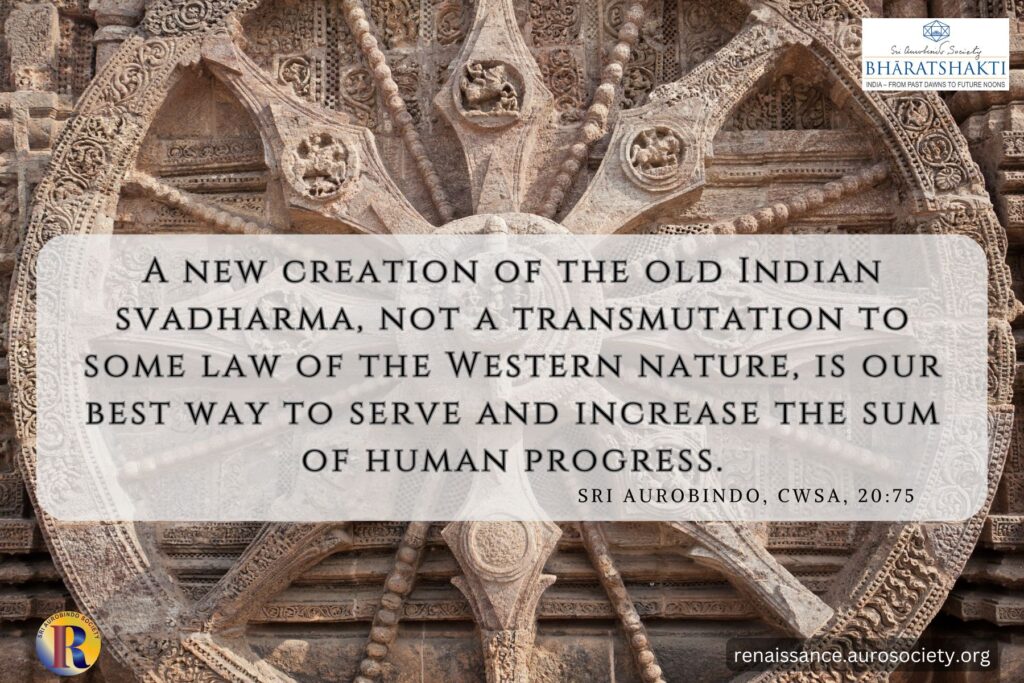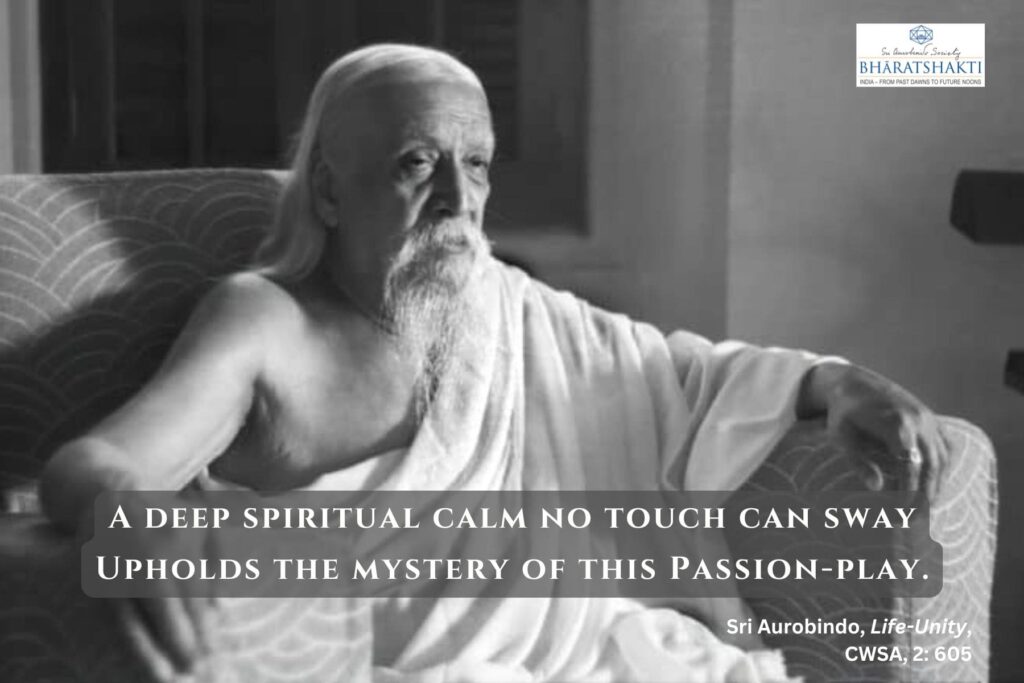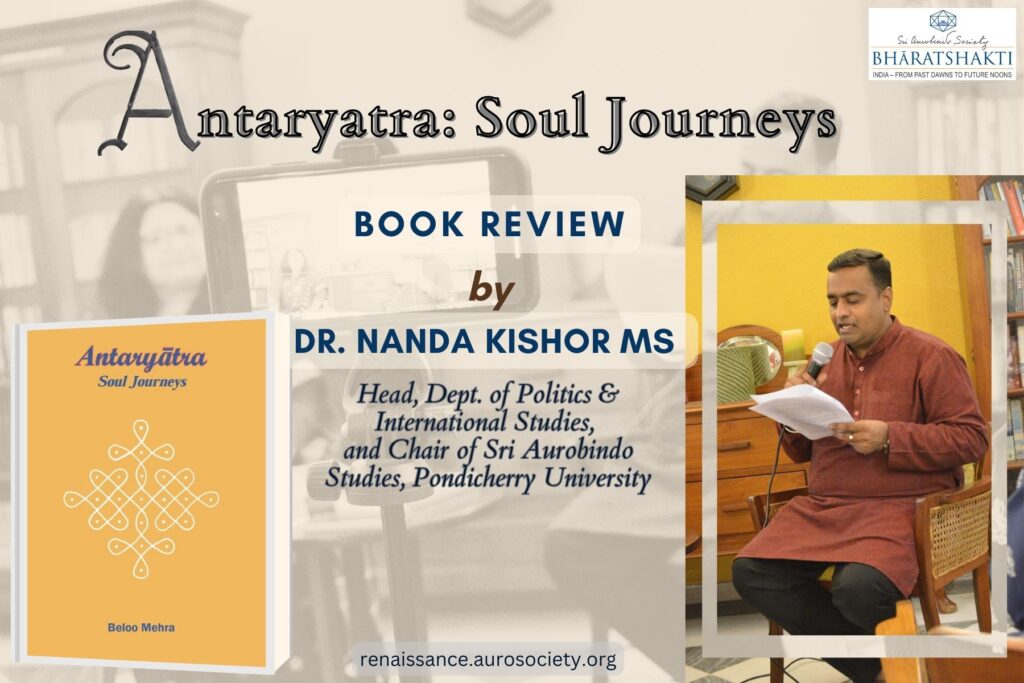Volume 1, Issue 4
Author: Agali Venkappa Sastri
Continued from Part 3
THE FOUNDATIONS OF INDIAN NATIONALISM
We must go back to the visions of our ancient Rishis if we truly wish to understand the Indian perspective on nationalism.
The Rishi in India
The Rishi has been at the head of social, religious and political guidance of the people in India, since times immemorial. With him is the fire, the ardour, the vision, the secret force of all evolution. The Rishi is not the author of a creed or a dogma. He is the seer of Truth. He seizes consciousness in its totality.
Realisation of the Transcendent is one thing. It is instantaneous in its incidence. Its embodiment in earthly forms, in appropriate conventions and institutions, creating counterparts here on earth, working on recalcitrant stuff, on a subconscient mass of humanity is quite another and takes long.
Where the vision is limited, there can be rapid materialisation thereof. Where the aspiration is transcendent, where the human collectivity is diverse and numerically large, and where, in addition, the territory is a subcontinent, it takes stupendously long to evolve. Such have been the factors of Indian evolution.
The Rishis, being mystics and being bound to secrecy according to the tradition of mystics everywhere, invented double meanings, exoteric and esoteric, the first meant for the less evolved, the physical man and the second for the duly initiated, the spiritually awakened.
The Rishis speak of themselves as hearers of the Truth, satyasrutah, and the knowledge received by this hearing as sruti.
~ CWSA, Vol. 16, p. 18
In images of physical Nature, the Vedic poets sing the hymn of our spiritual ascension; that ascension has already been effected by the Ancients, the human forefathers, and the spirit of these great Ancestors still assist their offspring; for the new dawns ripe at the old and lean forward in light to join the dawns of the future.
~ ibid, p. 29
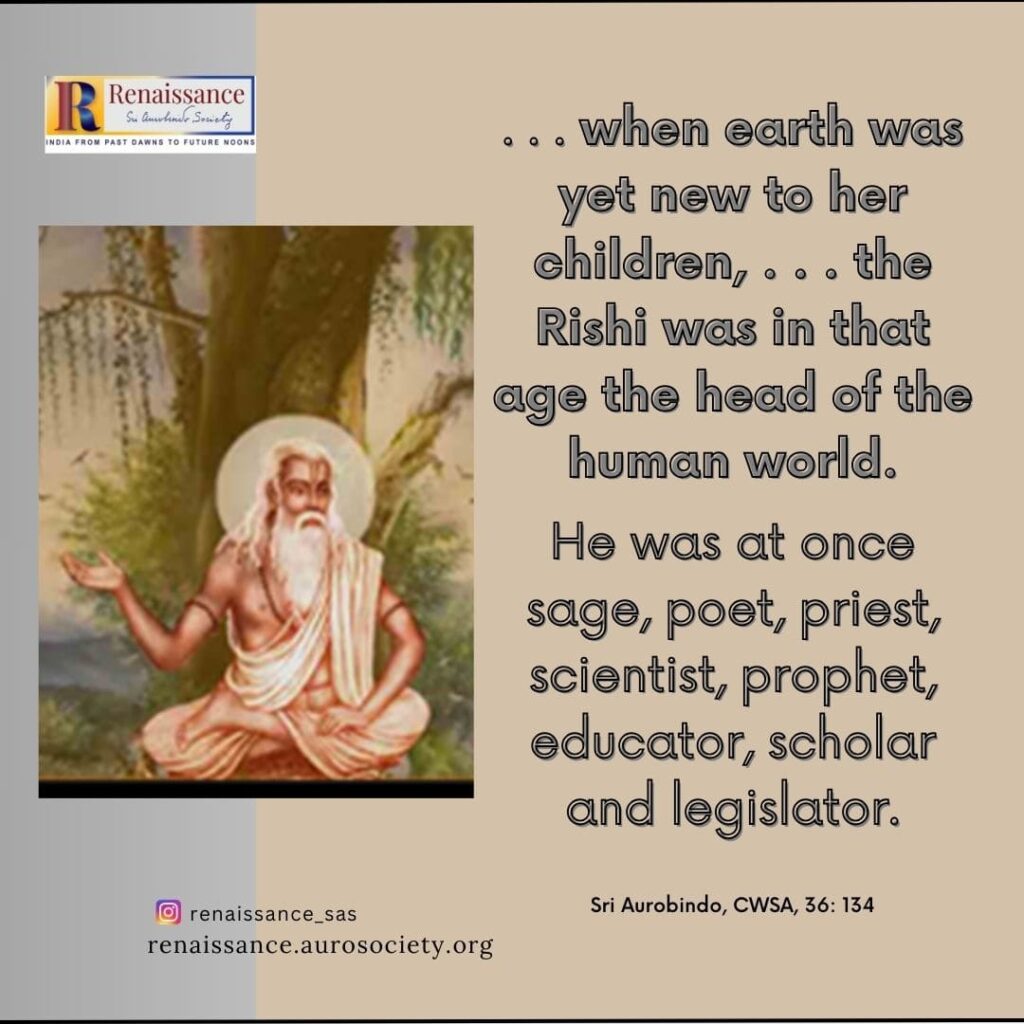
The Secret Knowledge of the Rishis
The thought around which all is centred is the seeking after Truth, Light, Immortality. There is a Truth deeper and higher than the truth of outward existence, a light greater and higher than the light of human understanding which comes by revelation and inspiration, an immortality towards which the soul has to rise.
We have to find our way to that, to get into touch with this Truth and Immortality, sapanta ṛtam amṛtam, to be born into the Truth, to grow in it, to ascend in spirit into the world of Truth and to live in it. To do so is to unite ourselves with the Godhead and to pass from mortality to immortality. This is the first and the central teaching of the Vedic mystics. […]
There is the inferior truth here of this world mixed as it is with much falsehood and error, anṛtasya bhūreḥ, and there is a world or home of Truth, sadanam ṛtasya, the Truth, the Right, the Vast, satyam ṛtaṁ bṛhat, where all is Truth-conscious, ṛtacit.
There are many worlds between up to the triple heavens and their lights but this is the world of the highest Light – the world of the Sun of Truth, swar, or the Great Heaven. We have to find the path to this Great Heaven, the path of Truth, ṛtasya panthāḥ or as it is sometimes called the way of the Gods. This is the second mystic doctrine.
The third is that our life is a battle between the powers of Light and Truth, the Gods who are the Immortals and the powers of Darkness…. We have to invoke the Gods by the inner sacrifice and by the word call them into us – that is the specific power of the Mantra, – to offer to them the gifts of the sacrifice and by that giving secure their gifts, so that by this process we may build the way of our ascent to the goal.
The elements of the outer sacrifice in the Veda are used as symbols of the inner sacrifice and self-offering; we give them what we are and what we have in order that the riches of the divine Truth and Light may descend into our life and become the elements of our inner birth into the Truth, – a right thinking, a right understanding, a right action must develop in us which is the thinking, impulsion, and action of that higher Truth, ṛtasya preṣā, ṛtasya dhīti, and by this we must build up ourselves in that Truth. […]
Finally, as the summit of the teaching of the Vedic mystics comes the secret of the one Reality, ekaṁ sat or tad ekam which became the central world of the Upanishads. The Gods, the powers of Light and Truth are powers and names of the One, each God is himself all the Gods or carries them in him: there is the one Truth, tat satyam, and one bliss to which we must rise.
~ CWSA, Vol. 16, pp. 19-21
A Vast House of the Spirit
The age of the Upanishads took up the Vedic truth into its highest and most simple expression of intuition and experience but yet in a form which could lend itself to intellectual and philosophical statement and appreciation. Later the Puranas and Tantras widened the basis of Indian culture and made a catholic attempt to draw towards the spiritual truth minds of all classes and qualities.
…the outward basis of the early religion spoke to the outward physical mind of the people and took that as the starting-point of its appeal. But the new evolution tried to awaken a more inner mind even in the common man, to lay hold on his inner vital and emotional nature, to support all by an awakening of the soul and to lead him through these things towards a highest spiritual truth.
It attempted in fact to bring the mass into the temple of the spirit rather than leave them in the outer precincts. The outward physical sense was satisfied through its aesthetic turn by a picturesque temple worship, by numerous ceremonies, by the use of physical images; but these were given a psycho-emotional sense and direction that was open to the heart and imagination of the ordinary man and not reserved for the deeper sight of the elect or the strenuous tapasya of the initiates.
The secret initiation remained but was now a condition for the passage from the surface psycho-emotional and religious to a profounder psychic-spiritual truth and experience.
~ CWSA, Vol. 20, p. 210
The complex synthesis that we know today as Sanatana Dharma escapes rigid definition. When we think we have a positive statement, comes a negation and then a reconciliation. The forms of this faith are infinite because spirit is the essence of it and can create forms without limit, weave unpredictable patterns. The fluid capabilities of this faith which bewilder the positive mind are well brought out in the following description:
Indian religion founded itself on the conception of a timeless, nameless and formless Supreme, but it did not feel called upon, like the narrower and more ignorant monotheisms of the younger races, to deny or abolish all intermediary forms and names and powers and personalities of the Eternal and Infinite.
A colourless monism or a pale vague transcendental Theism was not its beginning, its middle and its end. The one Godhead is worshipped as the All, for all in the universe is he or made out of his being or his nature. But Indian religion is not therefore pantheism; for beyond this universality it recognises the supracosmic Eternal.
Indian polytheism is not the popular polytheism of ancient Europe; for here the worshipper of many gods still knows that all his divinities are forms, names, personalities and powers of the One; his gods proceed from the one Purusha, his goddesses are energies of the one divine Force.
Those ways of Indian cult which most resemble a popular form of Theism, are still something more; for they do not exclude, but admit the many aspects of God.
Indian image-worship is not the idolatry of a barbaric or undeveloped mind; for even the most ignorant know that the image is a symbol and support and can throw it away when its use is over.
The later religious forms which most felt the impress of the Islamic idea, like Nanak’s worship of the timeless One, Akala, and the reforming creeds of today, born under the influence of the West, yet draw away from the limitations of Western or Semitic monotheism. Irresistibly they turn from these infantile conceptions towards the fathomless truth of Vedanta.
The divine Personality of God and his human relations with man are strongly stressed by Vaishnavism and Shaivism as the most dynamic Truth; but that is not the whole of these religions, and this divine Personality is not the limited magnified-human personal God of the West.
Indian religion cannot be described by any of the definitions known to the occidental intelligence. In its totality it has been a free and tolerant synthesis of all spiritual worship and experience. Observing the one Truth from all its many sides, it shut out none.
It gave itself no specific name and bound itself by no limiting distinction. Allowing separative designations for its constituting cults and divisions, it remained itself nameless, formless, universal, infinite, like the Brahman of its agelong seeking.
Although strikingly distinguished from other creeds by its traditional scriptures, cults and symbols, it is not in its essential character a credal religion at all but a vast and many-sided, an always unifying and always progressive and self-enlarging system of spiritual culture.
~ CWSA, Vol. 20, pp. 192-193
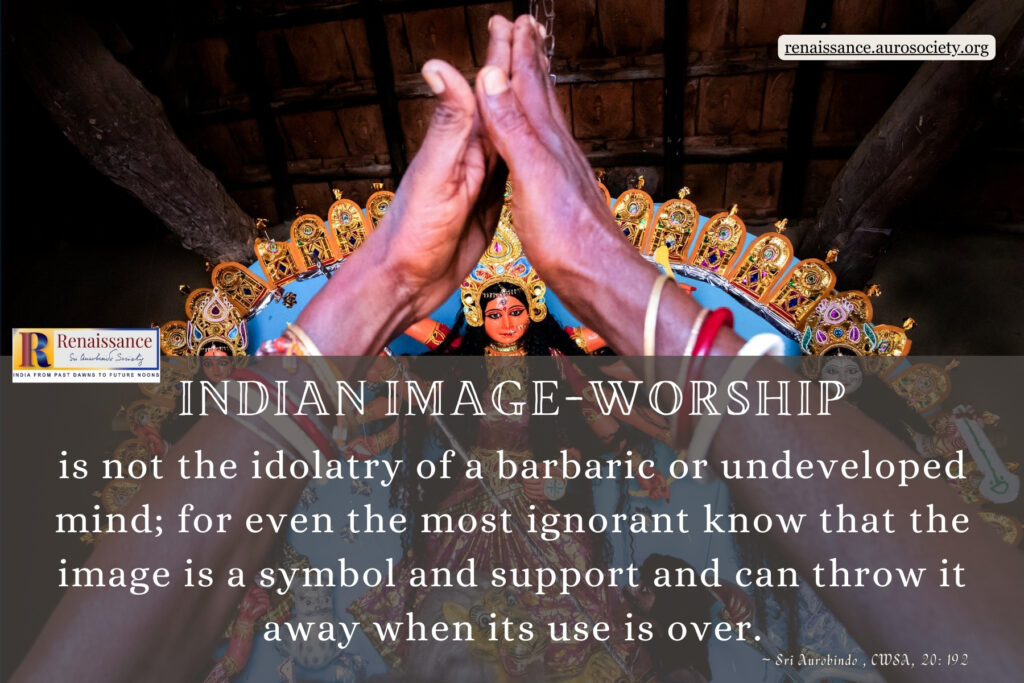
Sanatana Dharma, or Hinduism as it is also known today, is a vast House of the Spirit, not merely “a sounding labour-house vast of being” (Mathew Arnold) but a House of the Spirit with a thousand doors of entry, and humming with the voices of the votaries of many faiths who join in adoration of the Mother, some lighting up the lamp of knowledge, a few offering the incense of devotion and still others engaged in a ministry of service and sacrifice and all entitled to equal and impartial grace.
The Rishi as the Builder of a Polity
The whole problem of the Indian Rishi was how to find the transmitting medium, how to secure an outward basis in life that would reflect the light of the Spirit.
The business of the ancient Rishis was not only to know God, but to know the world and life and reduce it by knowledge to a thing well understood and mastered with which the reason and will of man could deal on assured lines and on a safe basis of wise method and order. The ripe result of this effort was the Shastra.
~ CWSA, Vol. 20, p. 224
The Rishis stand out as the builders of a polity. They achieved dispassion but did not renounce society; they stood above it, able to observe its trends and direct it along the destined lines of evolution by their force and vision.
The three main ideas which worked themselves into the warp and woof of institutions and helped man and society to realise their highest possibilities were:
- first, to discover and enter into unity with the One Existence to which sages gave various names,
- next, that the Spirit is manifested in all inner and outer Nature and can be approached in infinite ways determined by svabhāva and the principle of adhikāra[1], and
- lastly, that each individual being and all corporate being are forms of the divine Narayana.
It is this Transcendent, Universal and individual realisation of the Divine that helped the Rishis to conceive a social and religious order reconciling all conflict between the individual and society or nation by submitting both to a higher, the highest Truth. The foundations are above. The nourishment is from the super regions.
The process of such a social organisation is slow just because it is a maturing, a materialising of the spirit, the tendency to create whatever it had to create first on the inner plane and afterwards in its other aspects; the tendency to create from within outwards is the very essence of her way and stretches the development over long tracts of time.
Though the external tended to obscure the truth behind, a true spiritual sense was constantly kept alive by the shining examples of Saints and Seers. Though the utmost freedom, an almost “devastating catholicity” was permitted, at the same time spiritual order was ensured, firstly by the recognition of an enlarging number of authorised scriptures, secondly by the power of family and communal tradition, kuladharma, thirdly by the religious authority of Brahmins and finally by a succession, parampara of gurus or spiritual teachers.
It would exceed all length to try to give an account of details of the polity devised by the Rishis in their effort to embody their intuitions. But here are the essential points:
- The Rishis founded a religio-philosophic culture directed to the realization of the Highest and based on the subtlest understanding of individual and social psychology. It was not a rationally constructed social order but a living intuitive adaptation to complex social needs[2].
- The motives of life were not ignored nor their complexity underrated or lost sight of, but boldly envisaged and integrally woven into a scheme of graduated perfection.
- The sovereignty of the Dharma, a combination of freedom and order in the constitution of the four orders, a recognition, coordination and transcendence of the motives, the urges of life, signified by Dharma, Artha, Kama and Moksha, at once a concession to human nature and an ascending sublimation of the material, vital, mental, ethical, aesthetic and religious necessities of man, the regulation of the life of the individual by the four ashramas, gradually aiming at a super-social status, a life of spiritual freedom, – the four varnas mainly social in their incidence, the four ashramas mainly individual in their scheme, the four values of Dharma, Artha, Kama and Moksha at once individual and social in their scope and all the three institutions and valuations subtly interpenetrating and showing a profound appreciation of the organic unity of all human activity lend to the Indian polity a spirit and physiognomy all its own[3].
- Dharma was the cement of the whole fabric. It was a greater sovereign than the King. Dharma was interpreted by the Rishi, executed by the King who was but the guardian of the social and political order, and this Dharma permeated the common consciousness.
- The polity was at its basis communal, not individualistic or competitive. The complex communal polity here saw no clash of interest or incompatibility of aim between the individual and society because both were firmly held to be manifestations of the one Spirit that has assumed many forms. Everything else was regarded as an arrangement, a cooperative organization for the supreme ends of life about which there was no difference. It was however understood that it is the individual who leads because he is the luminous point of the social formation. In him society unfolding by slow subconscient workings becomes conscious, sees its own highest possibilities and is led by him to perfection.
- While admitting economic, political, social, ethical needs and utilities, the Indian polity at the same time instituted a hierarchy of values. It pointed at liberation as the highest aim. But it provided a preparatory discipline, a gradation, a preliminary satisfaction of the average human desires, interests and lesser play of life by putting Artha and Kama before Moksha. Artha and Kama are, however, not a law unto themselves; they are governed by Dharma. The determination of functions was psychological, strictly in accordance with svabhāva and svadharma. A single way of life, a single method does not bind all, the principle of adhikāra being an application, an extension of svabhāva.
- Evolution was by stages, by ascending tiers rather than by an impossible saltus. Everywhere we notice the same depth of insight, the same union of order and freedom, practical adequacy combined with transcendence.
Notes
[1] capacity; something in the immediate power of a man’s nature that determines by its characteristics his right to this or that way of yoga.
[2] “…the tendency of the reason when it pretends to deal with the materials of life as its absolute governor, is to look too far away from the reality of the society as a living growth and to treat it as a mechanism which can be manipulated at will and constructed like so much dead wood or iron according to the arbitrary dictates of the intelligence. The sophisticating, labouring, constructing, efficient, mechanising reason loses hold of the simple principles of a people’s vitality; it cuts it away from the secret roots of its life. The result is an exaggerated dependence on system and institution, on legislation and administration and the deadly tendency to develop, in place of a living people, a mechanical State.” (CWSA, Vol. 20, p. 400)
[3] Readers are encouraged to refer to various writings of Sri Aurobindo for the various aspects of the subject: how chaturvarna has social, economic, cultural and spiritual implications; how it has its counterparts in the cosmic in “the Wisdom that conceives the order and principle of things, the Power that sanctions, upholds and enforces it, the Harmony that creates the arrangement of its parts, the Work that carries out what the rest direct,” (CWSA, Vol. 25, p. 10); how very life may be figured in the symbolism of the varnas “as at once an inquiry after truth and knowledge, a struggle and battle of our will with ourselves and surrounding forces, a constant production, adaptation, application of skill to the material of life, and a sacrifice and service” (CWSA, Vol. 24, p. 749); varna as an institutional expression of svabhāva and svadharma, the interdependence of the varnas; varna and the modes of nature; varna in its purity and highest possibility and in its gross perversion, etc.

